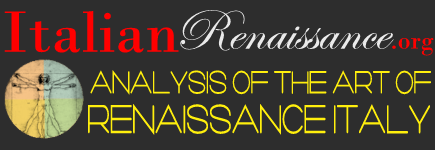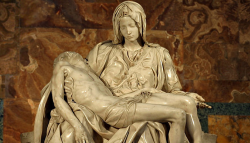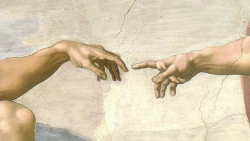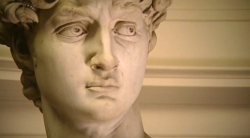Afterwards, Giotto having returned to Florence, Robert, King of Naples, wrote to Charles, King of Calabria, his first-born son, who chanced to be in Florence, that he should send him Giotto to Naples at all costs, for the reason that, having finished the building of S. Chiara, a convent of nuns and a royal church, he wished that it should be adorned by him with noble paintings. Giotto, then, hearing himself summoned by a King so greatly renowned and famous, went more than willingly to serve him, and, on arriving, painted many scenes from the Old Testament and the New in some chapels of the said convent. And the scenes from the Apocalypse that he made in one of the said chapels are said to have been inventions of Dante; and this may be also true of those at Assisi, so greatly renowned, whereof there has been enough said above. And although Dante at that time was dead, they may have held discourse on these matters, as often comes to pass between friends.
But to return to Naples; Giotto made many works in the Castel dell’Uovo, and in particular the chapel, which much pleased that King, by whom he was so greatly beloved that many times, while working, Giotto found himself entertained by the King in person, who took pleasure in seeing him at work and in hearing his discourse. And Giotto, who had ever some jest on his tongue and some witty repartee in readiness, would entertain him with his hand, in painting, and with pleasant discourse, in his jesting. Wherefore, the King saying to him one day that he wished to make him the first man in Naples, Giotto answered,[Pg 83] “And for that end am I lodged at the Porta Reale, in order to be the first in Naples.” Another time, the King saying to him, “Giotto, an I were you, now that it is hot, I would give over painting for a little;” he answered, “And I, i’ faith, an I were you.” Being then very dear to the King, he made for him a good number of pictures in a hall (that King Alfonso I pulled down in order to make the Castle), and also in the Incoronata; and among others in the said hall were the portraits of many famous men, and among them that of Giotto himself. Now the King having one day out of caprice besought him to paint his realm for him, Giotto, so it is said, painted for him an ass saddled, that had at its feet a new pack-saddle, and was sniffing at it and making semblance of desiring it; and on both the old pack-saddle and the new one were the royal crown and the sceptre of sovereignty; wherefore Giotto, being asked by the King what such a picture signified, answered that such were his subjects and such the kingdom, wherein every day a new lord was desired.
Departing from Naples in order to go to Rome, Giotto stopped at Gaeta, where he was forced to paint some scenes from the Old Testament in the Nunziata, which are now spoilt by time, but yet not so completely that there may not be seen in them very well the portrait of Giotto himself, near a large and very beautiful Crucifix. This work finished, not being able to refuse this to Signor Malatesta, he first occupied himself in his service for some days in Rome, and afterwards he betook himself to Rimini, of which city the said Malatesta was lord; and there, in the Church of S. Francesco, he made very many pictures, which were afterwards thrown to the ground and destroyed by Gismondo, son of Pandolfo Malatesta, who rebuilt the whole said church anew. In the cloisters of the said place, also, opposite to the wall of the church, he painted in fresco the story of the Blessed Michelina, which was one of the most beautiful and excellent works that Giotto ever made, by reason of the many and beautiful ideas that he had in working thereon; for besides the beauty of the draperies, and the grace and vivacity of the heads, which are miraculous, there is a young woman therein as beautiful as ever a woman can be, who, in order to clear[Pg 84] herself from the false charge of adultery, is taking oath over a book in a most wonderful attitude, holding her eyes fixed on those of her husband, who was making her take the oath by reason of mistrust in a black son born from her, whom he could in no way bring himself to believe to be his. She, even as the husband is showing disdain and distrust in his face, is making clear with the purity of her brow and of her eyes, to those who are most intently gazing on her, her innocence and simplicity, and the wrong that he is doing to her in making her take oath and in proclaiming her wrongly as a harlot.
In like manner, very great feeling was that which he expressed in a sick man stricken with certain sores, seeing that all the women who are round him, overcome by the stench, are making certain grimaces of disgust, the most gracious in the world. The foreshortenings, next, that are seen in another picture among a quantity of beggars that he portrayed, are very worthy of praise and should be held in great price among craftsmen, because from them there came the first beginning and method of making them, not to mention that it cannot be said that they are not passing good for early work. But above everything else that is in this work, most marvellous is the gesture that the aforesaid Blessed Michelina is making towards certain usurers, who are disbursing to her the money from the sale of her possessions for giving to the poor, seeing that in her there is shown contempt of money and of the other things of this earth, which appear to disgust her, and, in them, the personification of human avarice and greed. Very beautiful, too, is the figure of one who, while counting the money, appears to be making sign to the notary who is writing, considering that, although he has his eyes on the notary, he is yet keeping his hands on the money, thus revealing his love of it, his avarice, and his distrust. In like manner, the three figures that are upholding the garments of S. Francis in the sky, representing Obedience, Patience, and Poverty, are worthy of infinite praise, above all because there is in the manner of the draperies a natural flow of folds that gives us to know that Giotto was born in order to give light to painting. Besides this, he portrayed Signor Malatesta on a ship in this work, so naturally that he appears absolutely alive; and some mariners and[Pg 85] other people, in their promptness, their expressions, and their attitudes—and particularly a figure that is speaking with some others and spits into the sea, putting one hand up to his face—give us to know the excellence of Giotto. And certainly, among all the works of painting made by this master, this may be said to be one of the best, for the reason that there is not one figure in so great a number that does not show very great craftsmanship, and that is not placed in some characteristic attitude. And therefore it is no marvel that Signor Malatesta did not fail to reward him magnificently and to praise him.



